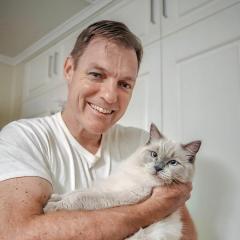-
Posts
210,025 -
Joined
-
Last visited
-
Days Won
3,387
Everything posted by Damien Symonds
-
I'm so sorry, I don't understand the question.
-

File size
Damien Symonds replied to Glynda horsfall's topic in Photoshop / Elements / Bridge / ACR questions or problems
It's so important, you know? We can never trust any form of digital storage to be safe ... in fact, it's best to assume that every drive could fail tomorrow. So never keep only one copy of your important files. -

Help with people removal from background
Damien Symonds replied to Linda Sutton's topic in Help with editing
Did you Option-click on my mask (to view it in black-and-white)? You'll see I gently applied it between the legs as well, to calm down those reflections. -
Yep, easily passable.
-

File size
Damien Symonds replied to Glynda horsfall's topic in Photoshop / Elements / Bridge / ACR questions or problems
Great! And are they exact copies of each other? Every file that's on one of them is also on the other? -

Colour issues
Damien Symonds replied to StasiaB's topic in Monitor calibration questions or problems
I know it must seem that we're getting off track. You must be wondering why I'm concentrating on the laptop screen when what you really want is the Samsung one calibrated. Well, I'm trying to establish that the Spyder is still ok. It's possible that it's faulty, you see. If we try all calibration options on the laptop, and you're still having these wild colour differences, I'm afraid we'll have to reach the conclusion that the Spyder is fried. But if the Spyder can calibrate the laptop ok, that will give us hope; and we can turn our attention to the more complicated matter of the Samsung calibration with some more optimism. -

Colour issues
Damien Symonds replied to StasiaB's topic in Monitor calibration questions or problems
Great. And can you confirm that you followed these exact instructions? Including the troubleshooting section at the bottom? (Native on and off) -

Colour issues
Damien Symonds replied to StasiaB's topic in Monitor calibration questions or problems
Ok, interesting. Remind me - which screen do you have calibrated at the moment - the laptop one or the Samsung one? -

screen too bright
Damien Symonds replied to Amanda Voller's topic in Monitor calibration questions or problems
I want to say that it's possible you've done everything right, and you really do need to calibrate to a lower brightness. And I'll tell you how to do that, don't worry. But we need to eliminate all the more common possibilities first. -

screen too bright
Damien Symonds replied to Amanda Voller's topic in Monitor calibration questions or problems
Ok. When you're comparing the print to the screen, you know that you must not hold the print close to the screen, yes? You MUST hold it out to the side. I'm sure you know this, it was in my calibration instructions. So my question is, did you make sure you held the print to the right side, away from the window? Holding it to the left side, so it was backlit by the window, would be catastrophic. -

screen too bright
Damien Symonds replied to Amanda Voller's topic in Monitor calibration questions or problems
No no, you did exactly right. This is good news. Now, a little more info needed ... you said the window is beside your computer. Which side? -

screen too bright
Damien Symonds replied to Amanda Voller's topic in Monitor calibration questions or problems
Are you saying you calibrated during the daytime? -

screen too bright
Damien Symonds replied to Amanda Voller's topic in Monitor calibration questions or problems
Do you understand why I'm asking you all these questions? Do you understand that your room light (at night) is much duller than the daylight which would be coming through your window if you were editing during the day? And do you understand what a HUGE impact the surrounding light has on your screen-to-print comparison? If you're holding your prints in dim room light, of course it will seem like you can't get your screen's brightness low enough to match them. PLEASE tell me you understand. -

screen too bright
Damien Symonds replied to Amanda Voller's topic in Monitor calibration questions or problems
No no no no no no no no no no no!!!!!!!!!!! It doesn't matter when you edited them, or even on which computer you edited them! As long as the prints are from your usual pro lab, you can compare them. What time of day is it there right now? -

screen too bright
Damien Symonds replied to Amanda Voller's topic in Monitor calibration questions or problems
Ok, let's start with the daytime. Have you compared your screen to your prints in the daytime? -

screen too bright
Damien Symonds replied to Amanda Voller's topic in Monitor calibration questions or problems
And do you do all your editing in the daytime? -

screen too bright
Damien Symonds replied to Amanda Voller's topic in Monitor calibration questions or problems
Yes, it's good to calibrate in the dark. But that's not what I mean. I want to know about the normal light. The light you edit in. The light you're comparing the prints to the screen in. -

screen too bright
Damien Symonds replied to Amanda Voller's topic in Monitor calibration questions or problems
I mean, how bright is your room light? It sounds like it must be much too dim. -

screen too bright
Damien Symonds replied to Amanda Voller's topic in Monitor calibration questions or problems
Hi Amanda, what type of screen is it? And which calibrator do you have? Most importantly, how's your light? https://www.damiensymonds.net/2012/01/light-around-your-computer.html

